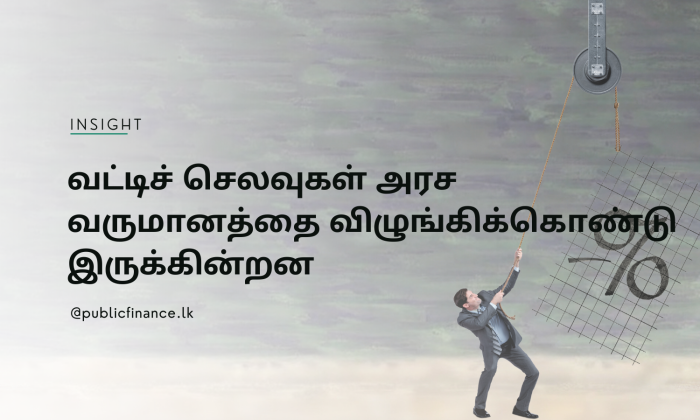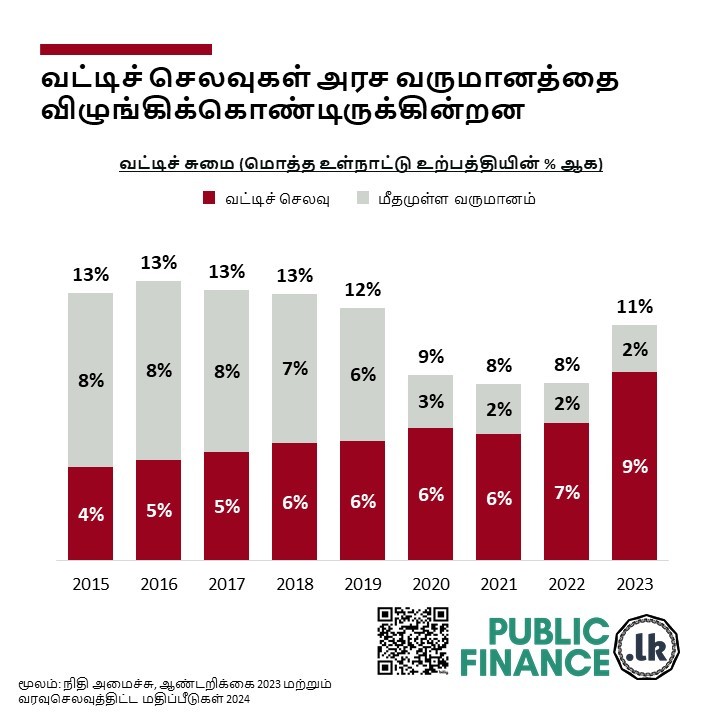


வரலாற்றில் முதல் முறையாக, 2023 ஆம் ஆண்டில், அரசாங்கம் அதன் மொத்த உள்நாட்டு உற்பத்தியில் 9% ஐ வட்டிக் கொடுப்பனவுகளுக்காக செலவிட்டுள்ளது, இது அரச வருமானத்தில் 80% ஆகும்.
ஒரு நாட்டின் கடன் நிலைத்தன்மைக்கு அதிக வட்டி-வருமான விகிதம் கடுமையான பாதிப்பை ஏற்படுத்தும். இந்த உயர் விகிதம் மேலும் கடன் வாங்க வேண்டிய தேவையை உருவாக்குவதோடு, கடன் நிலைத்தன்மையை வலுவற்றதாக்கி அத்தியாவசிய அரசாங்க செலவினங்கள் மற்றும் முதலீடுகளுக்கு வரையறுக்கப்பட்ட வருமானத்தையே விட்டுச்செல்கிறது.
இரண்டு காரணங்களினால் வட்டி-வருமான விகிதம் அண்மைய ஆண்டுகளில் அதிகரித்துள்ளது;
2019 இல் ஏற்பட்ட வரிக் குறைப்புக்களால் வருமானம் குறைந்தது
GDP இன் பங்காக அரசாங்க வருமானம் 2019 இல் 12% இலிருந்து 2020 இல் 9% ஆக குறைந்தது. இது முக்கியமாக 2019 இல் புதிதாக தேர்ந்தெடுக்கப்பட்ட அரசாங்கம் பல வரி விகிதங்களைக் குறைத்ததானாலாகும். இதனால், GDP இன் பங்காக வட்டிக்கொடுப்பனவுகள் 6% ஆக இருந்தபோதிலும், வருமானத்தில் வட்டியின் பங்கு 2019இல் 47% இலிருந்து 2020 இல் 71% ஆக அதிகரித்தது.
2. அதிக வட்டி விகிதங்கள் மற்றும் அதிக அரசாங்கக் கடன் காரணமாக வட்டிச் செலவுகள் உயர்ந்தன
மொத்த உள்நாட்டு உற்பத்தியில் ஒரு பங்காக வட்டிச் செலவினம் முன்-2021இல் 6% இலிருந்து 2023 இல் 9% ஆக அதிகரித்துள்ளது. இதற்கான காரணங்கள் (1) முந்தைய ஆண்டுகளில் 10% க்கும் குறைவாக இருந்த உள்நாட்டு வட்டி விகிதங்கள் பின்- 2021 இல் 25% க்கு மேலாக உயர்ந்தன - முக்கியமாக இறுக்கமான நாணய நிலைமைகள் மற்றும் வெளிநாட்டு நிதிக்கான அணுகல் இல்லாமை காரணமாக. (2) மொத்த உள்நாட்டு உற்பத்தியின் (GDP) சதவீதமாக மத்திய அரச கடனும் 2019 இல் 81.9% ஆக இருந்து 2022 இல் 114.2% ஆக கணிசமாக அதிகரித்ததோடு, இது அதிக வட்டி செலவிற்கு வழிவகுத்தது, ஏனெனில் பெறப்பட்ட அதிகப்படியான கடனுக்கு அரசாங்கம் அதிக வட்டி செலுத்த வேண்டியிருந்தது.
கடனைத் திருப்பிச் செலுத்தாத வெளிநாட்டுக் கடனுக்கான திரட்டப்பட்ட வட்டிச் செலவையும் சேர்த்திருந்தால், இந்த வட்டித் தொகைகள் மிக அதிகமாக இருந்திருக்கும் என்பதையும் கவனத்தில் கொள்ள வேண்டும்.

மூலங்கள்
நிதி அமைச்சு. ஆண்டறிக்கை (2023) https://www.treasury.gov.lk/web/annual-reports/section/2023 இல் [இறுதி அணுகல் 26 ஜூன் 2024].
நிதி அமைச்சு. வரவுசெலவுத்திட்ட மதிப்பீடுகள் (2024) https://www.treasury.gov.lk/web/budget-estimates/section/budget%20estimates%202024 இல் [இறுதி அணுகல் 26 ஜூன் 2024].